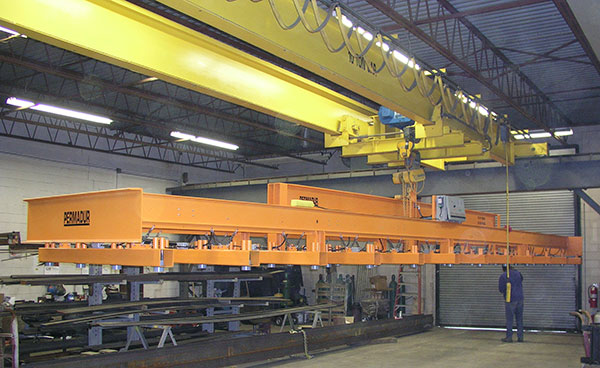The Core Principles of Material Handling
In the hustle and bustle of warehouses and manufacturing plants, the efficient movement and handling of materials often present significant challenges. From the strain of manual labor to the inefficiencies of poorly designed systems, these issues can hinder productivity and increase costs. Yet, understanding the fundamental principles of material handling can turn challenges into opportunities for improvement.
The Core Principles for Sheet Handling
- Planning Principle: Effective material handling begins with a comprehensive plan outlining the needs, performance objectives, and functional specifications of the methods employed. A well-thought-out plan considers the types of materials, the handling frequency, the distances involved, and the integration with an existing system. For instance, in a warehouse, strategic planning might involve optimizing the layout of storage racks to minimize travel distance for pickers, enhancing efficiency and reducing operational costs. Similarly, designing conveyor systems to move components between assembly stations in a manufacturing plant seamlessly ensures a streamlined production process, reducing downtime and improving productivity.
- Standardization Principle: Standardization in material handling is a powerful tool that reduces complexity and simplifies maintenance, instilling a sense of relief and confidence. It involves using uniform methods, equipment, controls, and software to create a cohesive system. Logistics companies often adopt standardized pallets and forklifts to ensure compatibility across various warehouses, facilitating smooth operations. Manufacturing facilities benefit from standardized conveyor belts and control systems, which streamline processes and make it easier to train employees, ultimately boosting efficiency and reducing errors.
- Work Principle: Minimizing the work involved in material handling, defined as the material flow multiplied by the distance moved, is crucial for maintaining productivity without compromising service levels. Automated guided vehicles (AGVs) are a prime example of this principle in action, as they reduce manual labor by autonomously transporting materials within a factory. High-density storage systems can also minimize travel distance for warehouse pickers, thereby increasing efficiency and reducing physical strain on workers.
- Ergonomic Principle: Recognizing human capabilities and limitations is not just a consideration but an essential part of designing safe and efficient material handling tasks. This principle, rooted in care and respect for the workforce, reduces physical strain and prevents injuries. For instance, height-adjustable workbenches and lift-assist devices help reduce back strain and other musculoskeletal disorders. Ergonomically designed hand trucks and carts facilitate more effortless movement of goods, enhancing safety and efficiency in the workplace.
- Unit Load Principle: The unit load principle focuses on configuring loads into appropriately sized units that can be handled efficiently throughout the supply chain. This approach improves handling efficiency and reduces the risk of damage. Consolidating multiple boxes on a single pallet simplifies transportation and storage, as seen in many logistics operations. Beverage companies, for instance, optimize loading and unloading times by configuring unit loads to match the capacity of their delivery trucks, ensuring smooth and efficient operations.
- Space Utilization Principle: Maximizing the effective use of available space, particularly cubic space, is crucial to efficient material handling. This includes optimizing storage layouts and utilizing vertical space to its full potential. Vertical storage solutions like mezzanines or automated storage and retrieval systems (AS/RS) significantly increase warehouse storage capacity. Additionally, narrow aisle racking systems enhance storage density, allowing for more efficient use of floor space and improving overall warehouse operations.
- System Principle: Integrating all material movement and storage activities into a coordinated system ensures smooth and efficient operations. A well-integrated system spans all areas of material handling, from receiving and inspection to storage, production, packaging, and shipping. In practice, integrating warehouse management systems (WMS) with transportation management systems (TMS) streamlines the flow of goods from storage to delivery. In manufacturing, synchronizing conveyor systems with production schedules maintains a steady flow of materials, reducing bottlenecks and enhancing productivity.
- Automation Principle: Automating material handling operations enhances efficiency, consistency, and safety while reducing the need for manual labor. Automation technologies, such as robotic palletizers, automate the stacking of products, increasing speed and accuracy. Automated sorting systems efficiently manage high volumes of parcels in distribution centers, improving throughput and reducing operational costs. By leveraging automation, businesses can achieve greater operational efficiency and responsiveness.
- Life Cycle Cost Principle: A thorough economic analysis of material handling equipment and systems must account for their entire life cycle, from acquisition to operation, maintenance, and disposal. Investing in durable, high-quality conveyor systems might have higher initial costs but offer lower long-term maintenance expenses, proving more cost-effective. Analyzing the total cost of ownership for various storage racks helps determine the most economical solution, ensuring that investments in material handling infrastructure are both practical and sustainable in the long run.
Get the most from Sheet Handling Systems
These principles enable organizations to design and implement material handling systems that enhance efficiency, reduce costs, and improve safety, ensuring smooth and productive operations.


